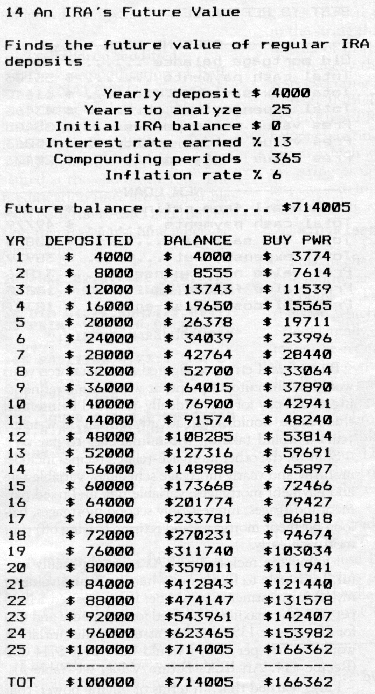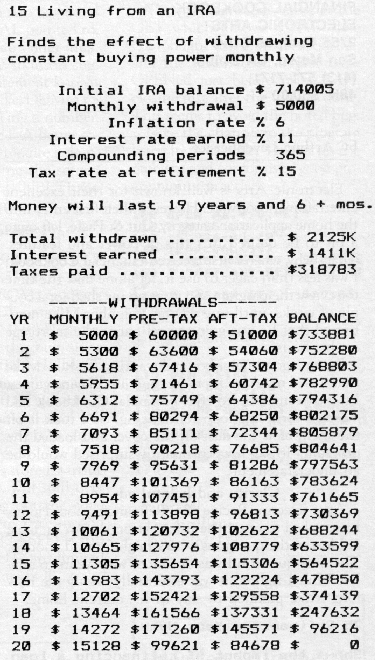FINANCIAL COOKBOOK
ELECTRONIC ARTS
2755 Campus Drive
San Mateo, CA 94403
(413) 571-7171
48K $50.00
by Arthur Leyenberger
Electronic Arts is well known for their excellent entertainment software. However, their first entry into the home application category, Cut & Paste, left quite a bit to be desired in terms of power and features. That's why, when I first received Financial Cookbook, I was less than eager to use it, let alone take the time to review the program. So it sat on my shelf for a couple of weeks, until one day my neighbor Mike mentioned that he was going to refinance the mortgage on his house.
Being a good neighbor and wanting to show Mike that I used my Atari for more than just playing games, I faintly remembered that Financial Cookbook had a recipe for home loan refinancing. So I took it off the shelf, blew the dust off the cover and loaded the program. To say I was pleasantly surprised would be an understatement.
Clarity and helpful advice.
After selecting Recipe #25: Refinancing Your Home, I was asked to enter the information shown in Table 1. Most of the questions were straightforward enough. The only question I was unsure of was "years to analyze." But I figured it was essentially asking me how long Mike planned to stay in his current home.
25 Refinancing Your Home
Shows the Impact of refinancing a loan
|
Original mortgage amount |
$ | 75000 |
|
Length of mortgage |
30 | |
|
Mortgage interest rate |
% | 14.5 |
|
Years paid an loan |
5 | |
|
Payoff penalty |
$ |
0 |
|
Amount of new loan |
$ | 75000 |
|
Length of mortgage |
30 |
|
|
Mortgage interest rate |
% |
13 |
|
Points paid |
% |
1 |
|
Other closing costs |
$ |
775 |
|
Years to analyze |
5 |
|
|
Estimated resale value |
$ |
95000 |
|
Interest rate earned |
% |
11 |
|
Compounding periods |
365 |
|
|
Marginal tax rate |
% |
22 |
Table 1.
After I told the program to calculate, the results appeared (see Table 2), faster than you could say "Certified Public Accountant" Best of all, the program gave us advice-BEST TO REFINANCE.
|
BEST TO REFINANCE |
||
|
------------- PRESENT LOAN ---------- |
||
|
Old mortgage balance |
$ | 73937 |
|
Total cash payments |
$ | 55105 |
|
Total tax savings |
$ | 11642 |
|
Total expense, net |
$ | 43463 |
|
Pres value net expenses |
$ | 35485 |
|
Pres value future equity |
$ | 15063 |
|
Pres value costs-equity |
$ | 20423 |
|
|
||
|
--------------- NEW LOAN ------------ |
||
|
Cash avail from refinance |
$ | -462 |
|
Total cash payments |
$ | 49779 |
|
Total tax savings |
$ | 10800 |
|
Total expense, net |
$ | 38979 |
|
Pres value net expenses |
$ | 31816 |
|
Pres value future equity |
$ | 13890 |
|
Pres value costs-cash-equity |
$ | 18387 |
Table 2.
By trial and error, we figured out that three years would be the cutover point, at which time refinancing would pay for itself Ideally, it would be useful if this recipe would automatically display how many years it would take for the refinancing to pay off.
Some of the other mortgage-related recipes include: monthly and yearly mortgage schedules, variable rate and payment mortgages, variable rate and fixed payment mortgages, interest-only second mortgages, balloon payment mortgages and retiring (paying off) your mortgage early.
I found the recipes for IRAs to be especially useful. I was able to figure out what the future value of my IRA investments would be. If I deposited $4000 per year (the maximum allowed for my spouse and me) for 25 years at 13% interest, assuming that inflation would be 6% per year, I would have over $714,000 (Recipe #14: An IRAs Future Value, see Table 3).
I also. learned that, in terms of buying power, that amount is roughly equivalent to about $166,000 in today's money. That really puts it in perspective. Then I used another recipe to determine that, if I withdrew $5000 per month, the amount saved in my IRA would last just over 19 years (Recipe #15: Living from an IRA, see Table 4).
What it will do.
Financial Cookbook contains thirty-two recipes or formulas for quickly determining such things as returns on investments, effective tax shelters and IRAs, the effects of inflation, mortgage calculations and tax rates. Each recipe asks the user to enter certain variables and makes calculations based on these.
All of these calculations are done without the need to build complicated models, as is required when using a spreadsheet. Also, knowledge of complicated financial formulas is not required to get results quickly and easily. The ability to instantly recalculate based

Table 3.
on changing one value, such as interest rate earned or expected inflation rate, really makes the program useful for answering those "what if" types of questions that invariably occur.
Some entries-like interest rate, marginal tax rate and expected inflation -appear in nearly every recipe. To save you the drudgery of having to retype this information each time you use a new recipe, Financial Cookbook has a profile command that lets you enter and save these numbers for future use. Once you enter your data with the profile command, it is entered automatically whenever a recipe calls for it. You can even save this data to your work disk. You can also save a copy of a filled-in recipe to your document disk. The document disk uses the same format as that of Cut & Paste, but, unfortunately, C&P cannot be used to edit the saved Financial Cookbook documents.

Table 4.
Sometimes the results of a recipe's calculations exceed the 20-line screen length. When this occurs, the display automatically scrolls down as the answer table is generated. When the output is finished, the cursor returns back to the top line of the recipe. You can then use the cursor control keys to scroll through the entire input and output of the recipe.
There is also a print command to let you send your input data and subsequent output to your printer. This is how Tables 1 and 2 were created. The print command tells your printer to print everything from the title line of the recipe to the last line of the table. If the amount of the output is greater than 66 lines, you must use continuous-form paper in your printer to accommodate it. Only one printer option is available, and it lets you choose to either send or not send line feeds to your printer.
|
THE RECIPES |
|
Understanding Your Marginal Tax Rate |
|
Single Savings Deposits |
|
Monthly Savings Deposits |
|
Deposit Needed for Future Purpose |
|
Monthly Deposit for Future Purpose |
|
Living on Your Savings |
|
Making Your Savings Last Forever |
|
Earning Interest with Treasury Bills |
|
Long Term Investments |
|
Finding the Equivalent Interest Rate |
|
A Future Payment's Present Value |
|
Monthly Payments' Present Value |
|
Saving Money with IRAs |
|
An IRA's Future Value |
|
Living from an IRA |
|
Early Withdrawals from an IRA |
|
How Much Life Insurance You Need |
|
Mortgage Schedule, Yearly |
|
Mortgage Schedule, Monthly |
|
Variable Rate Mortgages |
|
Variable Rate, Fixed Payment Mortgages |
|
Interest Only Second Mortgages |
|
Mortgages with Balloons |
|
A Loan's Interest Rate |
|
Refinancing Your Home |
|
Retiring Your Mortgage Early |
|
Buying or Renting a Home |
|
Energy Saving Devices |
|
Owning Your Car |
|
Fixing Your Car |
|
Buying a Car |
|
Leasing a Car |
The documentation included with Financial Cookbook is probably the best yet seen from Electronic Arts-and one of the best I've ever seen for any software running on an Atari. A complete instruction manual containing a tutorial, recipe instructions and index is provided. The manual also gives good, understandable explanations of financial and tax issues, plus a comprehensive glossary.
The results - a superb menu.
Financial Cookbook was written by Stan Trost with members of the Electronic Arts software staff. The program is suitable for anyone who makes decisions about personal money matters. Given that money is important to all of us, Financial Cookbook is one product that can be used by just about everyone. It should pay for itself the first time you use it to make a decision about your money ... especially with its petty cash price of only $50.00.
Turning your Atari computer into a financial advisor is both informative and fun. I highly recommend Financial Cookbook.